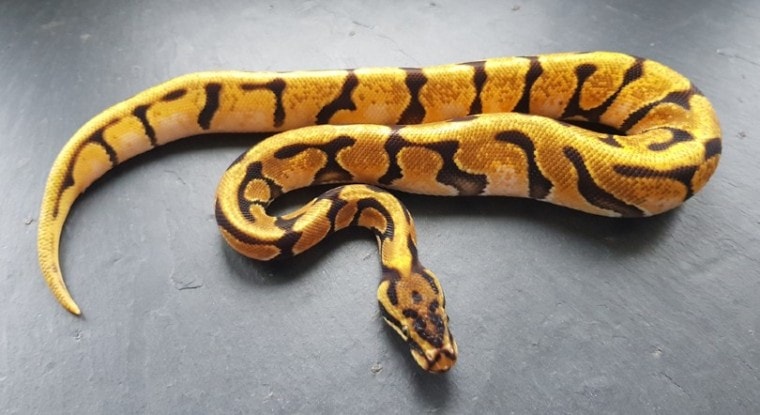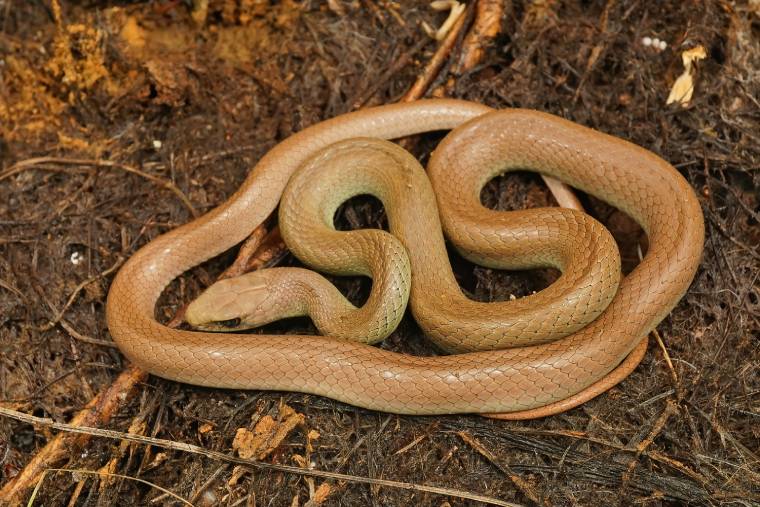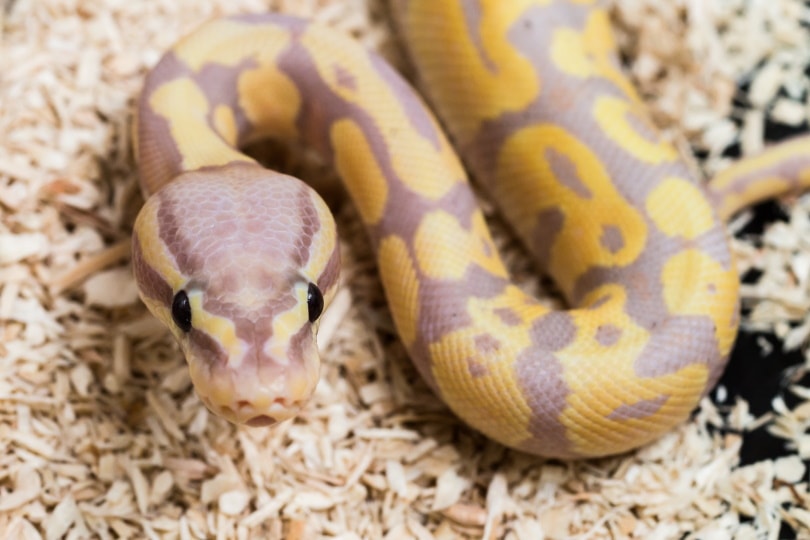
The Orange Dream Ball Python is a particular morph of ball python that features bright orange and yellow markings, hence the name. Due to the popularity of ball pythons, there are many different morphs available.
This morph is co-dominant. This means that in a regular mating scenario, with one of the parents being an Orange Dream Ball Python, about half the offspring will have this morph. The other half will look “normal” or have the morph of the other parent. On some occasions, you can get what’s called a “super” morph, which is where one offspring inherits two of the Orange Dream genes.
There are many different morphs you can combine with this one as well. For instance, the Super Orange Dream and Fire Spider combo is very sought after.
Beyond their appearance, these morphs act similar to other ball pythons. You take care of them in the same way, they simply look different.
Quick Facts about the Orange Dream Ball Python Morph
| Species Name: | Python regius |
| Common Name: | Orange Dream Ball Python |
| Care Level: | Low |
| Lifespan: | 30+ years |
| Adult Size: | 6 feet |
| Diet: | Rodents |
| Minimum Tank Size: | 36” x 18” x 12” |
| Temperament and Humidity: | 78 to 96 degrees F; 50% to 60% humidity |
Do Orange Dream Ball Pythons Make Good Pets?
Ball pythons are known for being docile and easy to care for. They are generally advertised as good beginner snakes for this reason. They don’t have any difficult care requirements and have very basic housing needs. For this reason, they are generally easier to care for them other snakes.
With the proper handling, ball pythons can actually be quite friendly. Most don’t mind being handled by humans as long as they are tamed appropriately. These snakes are also smaller than many other options, so they are typically a good option for those new to snakes. This also means that their cage will be smaller than other snakes, allowing you to fit them in smaller spaces.
Appearance
Unlike the usual ball python, the Orange Dream morph has orange and black markings. Sometimes, yellow markings are included as well. The exact coloration can vary. You can also combine this gene with other co-dominant genes, leading to unique colorations.
This snake is rather stocky and heavy for its size. However, it has a relatively tiny head. It cannot do much damage when biting people, which is one reason it is such a popular pet. The maximum adult length is about 6 feet, but many snakes stay smaller than this. Their scales are rather smooth and small.
Males are smaller than females by a bit. If you want a smaller snake, a male is probably the best option. However, it is difficult to sex a snake before they reach adulthood. Both sexes have pelvic spurs, so you can’t use that as an accurate method of sexing. However, males due tend to have larger spurs. This isn’t always a reliable method, though.
How to Take Care of an Orange Dream Ball Python
Habitat, Tank Conditions & Setup
Tank
Ball python tanks do not need to be fancy. You can use commercially available reptile tanks or a variety of other containers. Glass reptile terrariums are often adequate for these snakes, but you do want to avoid a screen top, as these can make it difficult to maintain the proper humidity.
These snakes do not do well in a large container, especially before they are fully grown. Smaller snakes can become stressed in larger enclosures, so it is important to start your snake in an enclosure that fits their size. Upgrade their tank as they get bigger. A 36” x 18” x 12” enclosure should be able to house an adult snake.
You will need a hiding box or even a couple of them. These snakes are shy and somewhat secretive.
Lighting
Supplemental lighting is not necessary for these snakes. However, you can use heating lamps if you choose. You can also use heating pads and other gadgets for heating instead.
If you do use lighting, be sure that it is on for 12 hours and then off for 12 hours. It should not be continuous, as this can be stressful for the snake. Instead, it should follow a usual lighting cycle.
Heating
The enclosure should have a proper thermal gradient. This allows the snake to adjust their body temperature as necessary. The basking spot should have a temperature of around 88 to 96 degrees Fahrenheit. The ambient temperature should be around 78 to 80 degrees Fahrenheit. You can use heating lamps or pads to achieve this. Be sure to accurately measure the temperature using a thermometer.
Humidity levels should be around 50% to 60%. This will ensure that the snake can shed properly, which is important for their overall health.
Substrate
Paper towels and newspapers are the easiest and cheapest substrate to use. These can be cleaned and changed very easily without upsetting the snake too much. You can also use cypress mulch or orchid bark, as these can help improve the tank’s humidity. However, you don’t want too much humidity. You’ll need to measure it and then change the substrate accurately.
You should avoid substrates that contain oils, as well as sand, shavings, and peat bedding.
Tank Recommendations
| Tank Type: | 36” x 18” x 12” enclosure |
| Lighting: | Not necessary |
| Heating: | Heating pad or heat lamp |
| Best Substrate: | Newspaper or paper towels |
Feeding Your Golden Dream Ball Python Morph
You should feed your ball python an appropriately-sized rodent once a week. It should be no larger than the circumference at your snake’s largest point. They should eat rats from a young age. They will likely need to start with very young rats and then work their way up.
After feeding, do not handle your pet for a day or two. This can mess with their digestion, as they need to lay still for a bit after eating. You should also never leave a live rodent with your snake, as it can cause injuries. You can buy frozen rodents and thaw them before serving them to your Orange Dream morph.
In the winter months, your snake may not eat as much as normal. This is typical. As long as your snake seems otherwise healthy, you shouldn’t worry about it. Continue to offer food every 10 to 14 days until your snake becomes interested in eating again.
Diet Summary
| Fruits: | 0% of diet |
| Insects: | 0% of diet |
| Meat: | 100% of diet |
| Supplements Required: | None |
Keeping Your Golden Dream Ball Python Morph Healthy
Common Health Issues
Ball pythons are usually pretty healthy. As long as their tank conditions are correct, they are not particularly unhealthy. They are prone to respiratory problems if the humidity and temperature are not correct. This usually turns into mouth rot, which involves an infection around the snake’s jaws.
Parasites are also possible and can usually be treated in your home. Mites and ticks are the most common issue.
Shedding problems can occur if the humidity is not high enough. Be careful and keep an eye on your snake while they are shedding to ensure that it comes off in one piece.
Lifespan
In captivity, these snakes usually live for about 30 years. However, some have lived for as long as 40 years.
Breeding
Females lay anywhere from three to 11 eggs—these eggs hatch after 55 to 60 days. Age is the only factor that determines a snake’s sexual maturity, which for females happens between 27 and 31 months after birth. Unlike other snakes, this species does not reach maturity based on size.
Are Golden Dream Ball Pythons Friendly? Our Handling Advice
These snakes are quite docile and shy. With proper handling, you can teach them to enjoy humans. You should always support your snake’s full weight and not make fast movements, as this can cause fearfulness.
Because of their shyness, these snakes may take more time to settle in than others.
Shedding: What to Expect
Like all snakes, ball pythons will shed. Their skin should come off in one piece. However, if it doesn’t, then the humidity needs to be increased. Proper shedding is important for your snake’s well-being. Stuck skin can cause all sorts of problems, so the proper humidity is important.
How Much Do Golden Dream Ball Pythons Cost?
Because of their rarity, these snakes can be quite expensive. They can cost anywhere from $500 to $2,500. It depends on whether the seller is certain that the snake is an Orange Dream, as well as the size of the snake. Larger snakes tend to be more expensive. Adult snakes tend to be more expensive, as they have a higher likelihood of surviving the switch in the environment.
Care Guide Summary
Conclusion
The Orange Dream Ball Python is exactly like every other ball python. However, they look quite a bit more exotic than most “normal” pythons. For this reason, they are typically more expensive. They are also quite a bit rarer, so you may have some difficulty finding them. Overall, these snakes are very easy to care for, and of course, they are a lot of fun to look at.
See Also:
Featured Image Credit: Deb Davis, Shutterstock










